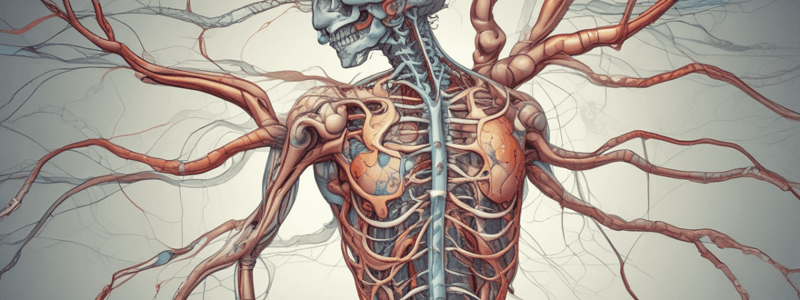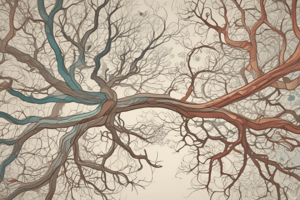Podcast
Questions and Answers
Which part of the nervous system interprets sensory information and responds to it with its own directives?
Which part of the nervous system interprets sensory information and responds to it with its own directives?
- Somatic Nervous System
- Central Nervous System (CNS) (correct)
- Peripheral Nervous System (PNS)
- Autonomic Nervous System
What is the primary function of motor nerves in the somatic nervous system?
What is the primary function of motor nerves in the somatic nervous system?
- Relay messages from the CNS to the body's skeletal muscles (correct)
- Transmit information from the sense receptors to the CNS
- Governs involuntary movements in the skin and bones
- Interprets sensory information coming in from the senses
What is the term for the nerves that transmit information from the sense receptors to the CNS?
What is the term for the nerves that transmit information from the sense receptors to the CNS?
- Somatic nerves
- Autonomic nerves
- Sensory nerves (correct)
- Motor nerves
What is the component of the nervous system that encompasses an extensive network of nerves connected to the brain and spinal cord?
What is the component of the nervous system that encompasses an extensive network of nerves connected to the brain and spinal cord?
What is the term for the neurons that fire in synchrony to carry messages in the nervous system?
What is the term for the neurons that fire in synchrony to carry messages in the nervous system?
What is the function of the CNS in relation to the body's functions?
What is the function of the CNS in relation to the body's functions?
What is the term for the part of the nervous system that includes all nerves that are not encased in bone?
What is the term for the part of the nervous system that includes all nerves that are not encased in bone?
What is the primary function of sensory nerves in the somatic nervous system?
What is the primary function of sensory nerves in the somatic nervous system?
Which of the following is NOT a function of the parasympathetic nervous system?
Which of the following is NOT a function of the parasympathetic nervous system?
The autonomic nervous system, a branch of the peripheral nervous system, is directly responsible for regulating conscious movements of the skeletal muscles.
The autonomic nervous system, a branch of the peripheral nervous system, is directly responsible for regulating conscious movements of the skeletal muscles.
The CNS, comprised of the brain and spinal cord, processes sensory information and orchestrates responses to it through a complex network of neurons.
The CNS, comprised of the brain and spinal cord, processes sensory information and orchestrates responses to it through a complex network of neurons.
All nerves that are not encased in bone are classified as part of the central nervous system.
All nerves that are not encased in bone are classified as part of the central nervous system.
The somatic nervous system, a subdivision of the PNS, transmits signals from the CNS to the muscles, allowing for voluntary muscle contractions.
The somatic nervous system, a subdivision of the PNS, transmits signals from the CNS to the muscles, allowing for voluntary muscle contractions.
The nervous system, a complex network of nerves, relies on the synchronized firing of neurons to relay information throughout the body.
The nervous system, a complex network of nerves, relies on the synchronized firing of neurons to relay information throughout the body.
The sensory nerves in the somatic nervous system transmit signals from the sense receptors to the CNS, allowing us to perceive the world around us.
The sensory nerves in the somatic nervous system transmit signals from the sense receptors to the CNS, allowing us to perceive the world around us.
The CNS, comprising the brain and spinal cord, only controls conscious, voluntary actions in the body.
The CNS, comprising the brain and spinal cord, only controls conscious, voluntary actions in the body.
The peripheral nervous system (PNS) transmits messages only from the body to the brain, not vice versa.
The peripheral nervous system (PNS) transmits messages only from the body to the brain, not vice versa.
The sympathetic nervous system is responsible for "resting and digesting" functions.
The sympathetic nervous system is responsible for "resting and digesting" functions.
The spinal cord is directly connected to the brain via a network of nerves.
The spinal cord is directly connected to the brain via a network of nerves.
The peripheral nervous system is the part of the nervous system that is encased in bone.
The peripheral nervous system is the part of the nervous system that is encased in bone.
The autonomic nervous system regulates voluntary actions.
The autonomic nervous system regulates voluntary actions.
The parasympathetic nervous system is responsible for mobilizing the body's resources during emergencies.
The parasympathetic nervous system is responsible for mobilizing the body's resources during emergencies.
Interneurons are responsible for transmitting sensory information to the brain.
Interneurons are responsible for transmitting sensory information to the brain.
The somatic nervous system controls the body's internal organs.
The somatic nervous system controls the body's internal organs.
The sympathetic nervous system slows down heart rate and breathing.
The sympathetic nervous system slows down heart rate and breathing.
The spinal cord is capable of independent action in certain situations, such as the withdrawal reflex.
The spinal cord is capable of independent action in certain situations, such as the withdrawal reflex.
The brain is the only part of the nervous system that can interpret sensory information and respond with directives.
The brain is the only part of the nervous system that can interpret sensory information and respond with directives.
Flashcards are hidden until you start studying
Study Notes
Nervous System Overview
- The nervous system acts as the body's electrical information highway, composed of nerves—bundles of interconnected neurons.
- It consists of the central nervous system (CNS) and the peripheral nervous system (PNS).
Central Nervous System (CNS)
- The CNS includes the brain and spinal cord, acting as the major control center for bodily functions.
- Responsible for interpreting sensory information and formulating responses.
- Receives neural impulses from sensory organs and sends commands to the rest of the body.
Peripheral Nervous System (PNS)
- Encompasses all nerves not encased in bone, located outside the skull and spine.
- Functions to transmit messages between the body and the CNS.
- Divided into somatic and autonomic nervous systems.
Somatic Nervous System
- Governs voluntary movements and contains both sensory and motor nerves.
- Sensory nerves carry information from sense receptors to the CNS.
- Motor nerves convey messages from the CNS to skeletal muscles.
Autonomic Nervous System
- Regulates involuntary bodily functions without conscious control.
- Manages internal organ function and smooth muscle activity in areas like the heart and gastrointestinal system.
- Further divided into sympathetic and parasympathetic nervous systems.
Sympathetic Nervous System
- Activates during stressful situations, enabling the "fight-or-flight" response.
- Prepares the body for action by increasing heart rate, blood flow to muscles, and speeding up respiration.
- Example: Responding to a perceived threat by enhancing physical readiness.
Parasympathetic Nervous System
- Restores the body to calm after stress, reversing sympathetic effects.
- Slows heart rate, stabilizes pulse, and normalizes digestion.
- Acts as a counterbalance to the sympathetic system, maintaining homeostasis.
Spinal Cord Functions
- Serves as an extension of the brain, linking the CNS with the body.
- Transmits messages between the brain and peripheral nerves.
- Protected by bone and spinal fluid, which also absorbs shocks.
Reflex Actions
- The spinal cord can initiate reflex actions independently of the brain to protect the body from harm.
- In a painful stimulus response (e.g., touching a hot surface), sensory neurons relay signals to interneurons in the spinal cord, activating motor neurons to withdraw the hand instantly.
- This reflex occurs rapidly and is recorded before the brain processes the pain, prompting potentially protective actions afterward.
Nervous System Overview
- The nervous system acts as the body's electrical information highway, composed of nerves—bundles of interconnected neurons.
- It consists of the central nervous system (CNS) and the peripheral nervous system (PNS).
Central Nervous System (CNS)
- The CNS includes the brain and spinal cord, acting as the major control center for bodily functions.
- Responsible for interpreting sensory information and formulating responses.
- Receives neural impulses from sensory organs and sends commands to the rest of the body.
Peripheral Nervous System (PNS)
- Encompasses all nerves not encased in bone, located outside the skull and spine.
- Functions to transmit messages between the body and the CNS.
- Divided into somatic and autonomic nervous systems.
Somatic Nervous System
- Governs voluntary movements and contains both sensory and motor nerves.
- Sensory nerves carry information from sense receptors to the CNS.
- Motor nerves convey messages from the CNS to skeletal muscles.
Autonomic Nervous System
- Regulates involuntary bodily functions without conscious control.
- Manages internal organ function and smooth muscle activity in areas like the heart and gastrointestinal system.
- Further divided into sympathetic and parasympathetic nervous systems.
Sympathetic Nervous System
- Activates during stressful situations, enabling the "fight-or-flight" response.
- Prepares the body for action by increasing heart rate, blood flow to muscles, and speeding up respiration.
- Example: Responding to a perceived threat by enhancing physical readiness.
Parasympathetic Nervous System
- Restores the body to calm after stress, reversing sympathetic effects.
- Slows heart rate, stabilizes pulse, and normalizes digestion.
- Acts as a counterbalance to the sympathetic system, maintaining homeostasis.
Spinal Cord Functions
- Serves as an extension of the brain, linking the CNS with the body.
- Transmits messages between the brain and peripheral nerves.
- Protected by bone and spinal fluid, which also absorbs shocks.
Reflex Actions
- The spinal cord can initiate reflex actions independently of the brain to protect the body from harm.
- In a painful stimulus response (e.g., touching a hot surface), sensory neurons relay signals to interneurons in the spinal cord, activating motor neurons to withdraw the hand instantly.
- This reflex occurs rapidly and is recorded before the brain processes the pain, prompting potentially protective actions afterward.
Studying That Suits You
Use AI to generate personalized quizzes and flashcards to suit your learning preferences.




